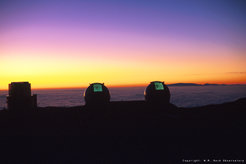Towards an exquisite look at black holes
The Keck interferometer directly resolves the accreting material around supermassive black holes in galactic nuclei

The nuclei of many galaxies show very intense radiation from X-ray to optical, infrared, and radio, where the nucleus sometimes exibits a strong jet. These Active Galactic Nuclei (AGN) are thought to be powered by accreting supermassive black holes. The accreting gas and dust are especially bright in optical and infrared (IR) radiation.
In May 2009, Makoto Kishimoto and his team successfully observed 4 such AGN with the Keck Interferometer at Hawaii. Their target sources included NGC 4151, a relatively nearby galaxy only 50 Million light years away, but also a distant quasar at redshift 0.108 (corresponding to a distance of more than a Billion light years). "This was only possible due to the huge effort of the Keck staff members to improve the sensitivity of the instrument", says Makoto Kishimoto, the paper's leading author. The United Kingdom Infrared Telescope (UKIRT) was used to follow up the Keck observations in order to obtain up-to-date near-IR images of the galaxies.
Astronomers have been trying to directly see how the supermassive black hole is eating up the surrounding gas and how the strong jet is being launched around the black hole. However, to spatially resolve such a distant object at IR wavelengths, a telescope having a diameter of the order of 100 m would be required. Instead of building such a huge telescope, a more practical way is to combine the beams from two or more telescopes that are so far apart in order to detect an interference pattern of the two beams and infer what the black hole vicinity looks like.
"The technique we are using is very new and very demanding in terms of observing conditions and data analysis", says Robert Antonucci from the University of California at Santa Barbara, co-author of the paper.
In the future, there will be many telescopes, or a telescope array extended over several kilometers. Such arrays have already been used at radio, but not yet at IR or optical wavelengths. Optical/IR interferometry is still in an early stage - currently using two or three telescopes. A prototype array is formed by the two Keck telescopes of 10 m diameter each, the so-called Keck interferometer (KI).

While the Keck Interferometer has been used to observe many stars in our Galaxy, it has been quite challenging to observe objects outside of our Galaxy, especially supermassive black holes in the nuclei of other galaxies. This is simply because they are much fainter. Interferometric observations of such objects especially at the shorter side of IR wavelengths, or near-IR, has been particularly difficult. The difficulty is directly related to the size of the wavelength - e.g. in the radio wavelength which is much longer than IR wavelengths, the interferometric technique is already used routinely.
Until recently, only one AGN has been successfully observed with the KI. This galaxy, NGC 4151, is one of the brightest of these sources in the optical/IR wavelengths. The new, more sensitive observations of four galaxies have lead to quite a clear picture of what is being resolved - a ring-like emission of dust grains, co-existing in the accreting gas, which are hot enough to be sublimating.
Utilizing different, independent measurements of the radius of this dust sublimation region (which come from the analysis of the variabilities of the optical and IR light), the team thinks that they have also possibly started to probe how the accreting material is distributed radially from the black hole - i.e. how compact or how extended the material distribution is.
"While we have got the highest spatial resolution in the IR, this is still a relatively outer region of the central black hole system", says Makoto Kishimoto. "We hope to achieve an even higher resolution using telescopes that are much further apart in order to get even closer to the center, and we also hope to observe many other supermassive black hole systems.

